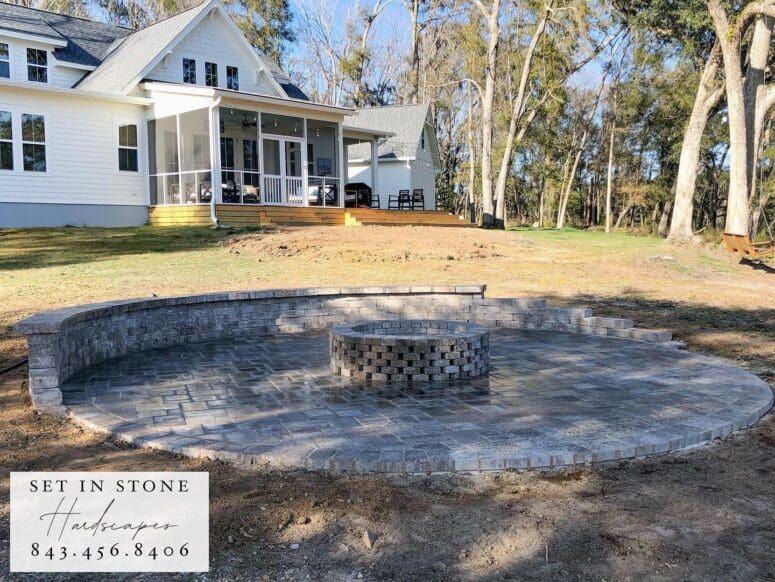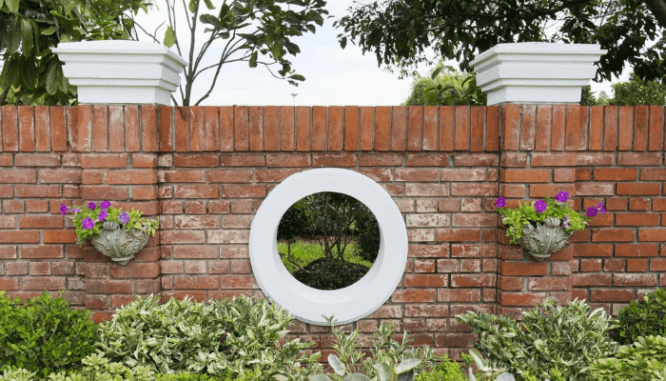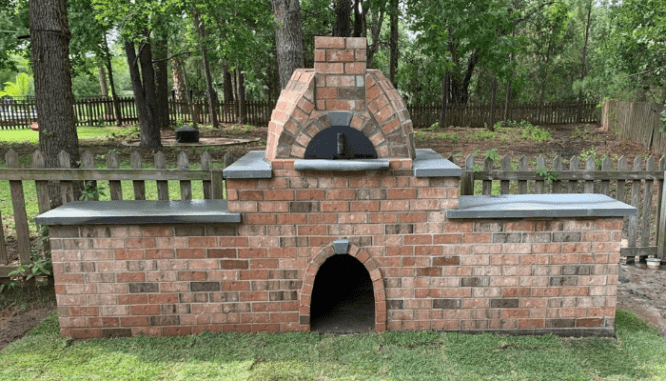7 Stunning Ways to Use Decorative Bricks For Landscaping
- Published on
- 8-9 min read
-
 Denise K. James Contributing AuthorClose
Denise K. James Contributing AuthorClose Denise K. James Contributing Author
Denise K. James Contributing AuthorDenise K. James is a writer and editor who specializes in writing about real estate, small business, travel and lifestyle.
Bricks are a timeless building material dating back to the colonial era in the U.S. Made from fire or sun-dried clay, bricks can withstand the elements while maintaining a classic beauty. That makes them a popular choice for both structural and decorative accents outside the home. When it comes to outdoor spaces, you can enhance elements like fire pits, walkways, flower bed edging and more with bricks.
Technically, brick elements in your outdoor area are known as the hardscape: parts of the landscape that are not alive. Hardscaping can help beautify the area without adding the extra maintenance that living plants require.
We spoke to three top-tier landscaping companies — Grandscapes, Father Nature Landscapes and Set in Stone Hardscapes — to gather 7 gorgeous decorative brick suggestions that enhance your existing landscaping. We even included noteworthy design features and cost estimations for each project. Read on, and get inspired to tackle your next landscaping project using bricks!

1. Install a brick walkway in a decorative pattern.
A brick walkway adds beauty to your garden area, front entrance, or another focal point in the yard. With an entire walkway made of brick, you have the opportunity to select an intriguing pattern that draws the eye and maximizes decorative appeal. The brick pattern shown in this walkway, designed by award-winning Charleston, South Carolina landscaping company Grandscapes, is called herringbone, characterized by its distinctive V-shape, but you can choose from a variety of styles including stacked bond, running bond, basketweave, and more.
This project calls for brick pavers, which don’t have the holed cores of structural bricks and are meant to lay flat. Brick pavers themselves run at an affordable $0.25-$4 per brick, or roughly $4-$8 per square foot, according to pricing estimates from Home Advisor.
To install a brick paver walkway, you’ll need to excavate the path, pour one to two inches of graded base, add a sand layer, and install temporary guardrails as a border before you lay any bricks, according to a tutorial from This Old House.
Then, to keep the bricks from moving, you pour masonry sand between the pavers and wet the path down, adding more sand as needed. All in all, it’s a project calling for a “moderate” skill level and two eight hour days.
To hire a professional to complete this project, you can expect to pay between $900-$2,000 — or $10-$25 per square foot — according to estimates from HomeGuide.

2. Make concrete pop with brick edging.
Brick edging is a great way to add elegance and visual interest to your plain old concrete steps — without the full expense of going all-brick. Our example of decorative brick edging on concrete steps, also courtesy of Grandscapes, shows how the contrast of the red brick against white concrete makes the steps decorative in addition to functional.
Although installing brick edging is less labor-intensive than a walkway, given that you won’t have to dig as wide of a trench, it can still be a tricky project to tackle solo.
According to a DIY guide from Family Handyman on brick borders, it’s recommended to secure your edging with a compact gravel base and layer of sand, leveled with the use of a tool called a screed. You’ll also need to cut the pavers around any curves with a brick saw, and nail the edging in place with plastic paver edging.
Slopes and steps can add additional complexity to the installation. If this sounds outside of your comfort zone, you can hire a landscaping company to complete a standard edging project for an estimated $434-$566, or $17-$23 per linear square foot, according to pricing information from HomeWyse.

3. Brighten the evening with a decorative brick fire pit.
If you’re looking to level-up your firepit game beyond your portable Solo Stove or chiminea, consider adding a permanent (and decorative!) brick fire pit — complete with a surrounding seating area for guests.
Set in Stone Hardscapes, a family-owned-and-operated company in Charleston, South Carolina, with a specialty license in Masonry & Carpentry through the SCLLR Builders Association, designed this firepit to include gaps between bricks for optimal ventilation. While some premade firepits don’t have gaps, this design helps the fire receive oxygen and burn longer into the night.
“A fire pit or outdoor fireplace can add warmth to a cool evening, while serving as a focal point for a patio or backyard living area,” note Set in Stone owners Steve and Felicia Baugh.
“Bricks provide a classic look to your fire feature and if installed correctly, will last for generations.”
Not only can a firepit increase your own enjoyment of the backyard, it can also boost resale value. According to 2020 survey we conducted at HomeLight, the #1 outdoor upgrade homebuyers want to see is a fire pit, cited by 54% of top real estate agents as a top amenity in their market. In chilly regions such as the Northeast (where 69% of top agents cite a fire pit as a top feature) and Midwest (59%), the appeal of having a bonfire on a crisp, fall evening is even stronger.
The cost to install a brick fireplace or fire pit can range from $300 to $1,400, according to Home Advisor. You can save money by going with a prefab kit, but don’t expect the ready-made options to last as long as a version built from scratch. Before you schedule an install, however, check to see which types of fire pits your county allows. Many municipalities ban wood-burning fire pits due to the smoke, sparks, and ember emissions — and if you go with natural gas or propane, it will require additional equipment and planning to install.

4. Create a secret garden aesthetic with a decorative brick wall.
If you have a garden, a decorative brick wall lends a traditional, romantic vibe, like this example — also from Set in Stone Hardscapes. This particular wall includes a special feature called a moon gate, which was known as a symbol of wealth in ancient Chinese gardens, as well as pillars topped with wooden caps.
The key to building a structurally sound brick garden wall is to stack the bricks atop a layer of level concrete so that it can withstand the freeze and thaw cycles, according to a tutorial from Hunker. You’ll need to account for approximately 6 bricks per square foot (adding a little cushion for wastage) and use type N mortar. For a garden wall, you can get away with using the cheaper, lower-class bricks unsuitable for buildings — or even go with recycled bricks, Hunker notes.
However, this project is not for the DIY novice, as you’ll need to outline your trench, pour the concrete footer, and plan out your brick-laying course using stake lines. Alternating joint patterns require cutting full bricks in half using masonry tools. But you can pay a professional to construct a garden wall for $4,880 on average, according to HomeAdvisor. Expect to pay between $10 and $45 per square foot for the wall.

5. Outline your garden beds with eye-catching brickwork.
Whether you fill them with colorful flowers or tidy shrubs, plant beds add beauty to your home exterior that can enhance your curb appeal. This brick hardscaping idea from Father Nature Landscapes — an Angi-certified company with headquarters in Birmingham, Alabama and Tacoma, Washington — shows how brick edging keeps beds tidy.
The single-brick edging pictured here is one of the simplest ways you can enhance your landscaping beds and maintain their neatness. The estimated cost of this project depends on how large your beds are and how many bricks you need to complete the edging. The national average cost for this project, according to Porch, ranges from $15.84 to $20.89 per linear foot. So, for example, if you have a bed that measures 10 feet, expect to pay between $158 and $209.

6. Construct decorative brick columns for a formal look.
Brick columns can beautify the entrance to your home or enhance any other focal point. This brick hardscaping idea, courtesy of Set in Stone Hardscapes, shows how simple brick columns can flank your driveway for a special architectural detail. The top of each column in this design is called a capital, added for ornamental purposes. According to Home Advisor, ornamental brick columns usually cost between $500 and $2,000 each, including labor.

7. Throw a pizza party with a decorative brick oven.
It’s every entertainer’s dream to have their own personal outdoor pizza oven, conveniently located in the backyard. A wood-fired pizza oven in particular may produce a cheesy pie with flavors reminiscent of your favorite pizza parlor. According to a tutorial video from Lowe’s, each course of masonry must be plumb and level to construct a sturdy pizza oven structure.
You’ll want to use fire brick — akin to the type of brick you’d find in a fireplace — for the area that will be in direct contact with the flames. Traditional pizza ovens have a herringbone core and dome shape, which is an efficient design for cooking — allowing you to bake your pizza in record time.
This elaborate brick oven from Grandscapes includes a bonus feature of bluestone countertops, a material that holds up against harsh weather and also slows bacterial growth. You can expect to pay anywhere between $1,500-$10,000 to install a stone oven, according to HomeAdvisor.

Pro tips for your decorative brick project
If you’re planning to DIY your decorative brick project, do your research ahead of time, gather the right materials, and make a plan. The following tips are courtesy of Jesse Clark, construction manager of GrandScapes.
1. Come up with a written plan for the project.
Sketch out your idea on paper first so that you can see it outside of your mind’s eye and, if necessary, show the idea to someone else. “Every hardscape project begins with a plan and a layout. It is important to measure the work area and sketch your ideas on paper,” Clark adds.
2. Begin with a solid surface before starting the project.
Whether you are creating a brick fire pit, a walkway, or other feature, you’ll need a solid surface to lay the bricks. For flat work, such as patios and walkways, Clark suggests a packed gravel base, while vertical brick work (think firepits or a garden wall) typically requires a concrete footer.
3. Know your mortar.
You can easily seal clay pavers with mortar. Mortar comes in a few different varieties, but most decorative projects will either call for Type N or Type S. According to Clark, Type N is best for above ground mortar placement, while S is better for below ground.
4. Keep cleaning supplies handy.
Clark suggests keeping a bucket of water and a sponge nearby for the purposes of wiping excess mortar — especially in the summer months, when the heat can make mortar dry quickly.
“Submerge your bricks in water before you apply mortar to them. When they’re hot, they will suck the moisture right out of the mortar and it will not adhere,” he notes.
You’re ready to pick a project!
As you can see, the options for using brick to accentuate your landscaping are vast. You could take on a simple addition such as brick edging to define your concrete steps, walkways, or garden beds while still boosting your curb appeal in a big way. Green thumbs may be enticed by the idea of a dreamy garden wall, while food lovers won’t be able to resist the chance to pull a piping hot pizza out of their own brick oven. Wherever your preferences lie — in columns or fire pits, grand entrances, or low maintenance edging — bricks remain an incredibly versatile stone for your next outdoor project.
Header Image Source: (Jarrod Reed / Unsplash)
